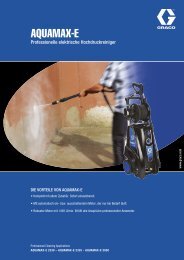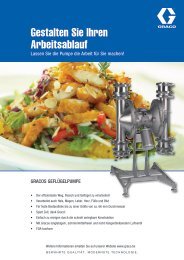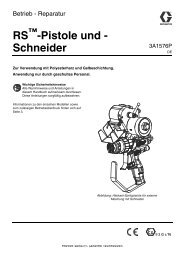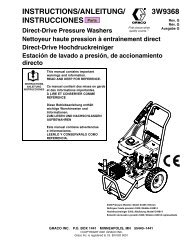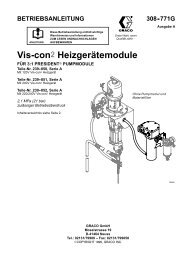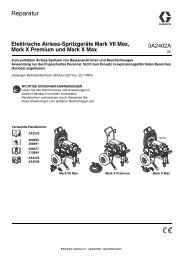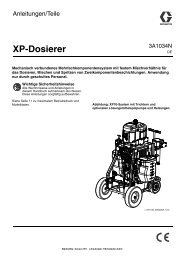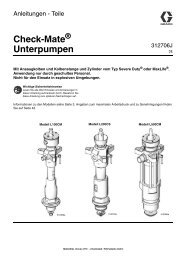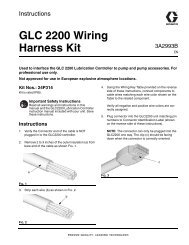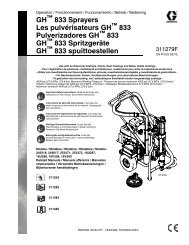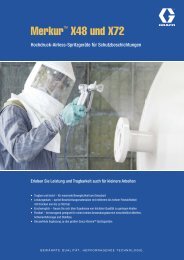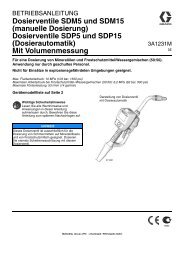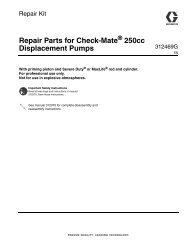307671D ULTRA 400 AIRLESS PAINT SPRAYER - Graco Inc.
307671D ULTRA 400 AIRLESS PAINT SPRAYER - Graco Inc.
307671D ULTRA 400 AIRLESS PAINT SPRAYER - Graco Inc.
You also want an ePaper? Increase the reach of your titles
YUMPU automatically turns print PDFs into web optimized ePapers that Google loves.
~ ~~<br />
STALL PRESSURE CALIBRATION<br />
I<br />
I<br />
USE<br />
WA RNlNG<br />
EXTREME CAUTION WHEN PERFORMING THIS CALIBRATION PROCEDURE to reduce the risk of a<br />
fluid injection injury or other serious bodily injury which can result from splashing, component rupture, electric<br />
shock, fire, explosion, or moving parts.<br />
This procedure sets the sprayer to 192 bar (2750 psi)<br />
MAXIMUM WORKING PRESSURE. This procedure<br />
must be performed whenever a new or used circuit<br />
board, or pressure control assembly is removed and<br />
reinstalled or replaced, to be sure the sprayer is properly<br />
calibrated.<br />
Improper calibration can cause the sprayer to overpressurize<br />
and result in component rupture, fire or<br />
explosion. It may also prevent the sprayer from obtaining<br />
the maximum working pressure which would<br />
result in poor sprayer performance.<br />
NEVER attempt to increase the fluid outlet pressure<br />
by performing this calibration in any other way.<br />
NEVER EXCEED 192 bar (2750 psi) MAXIMUM<br />
WORKING PRESSURE. Normal operation of the<br />
sprayer at higher pressures could result in component<br />
rupture, fire or explosion.<br />
AVOID touching.the wires in the pressure control<br />
assembly with your fingers or tools when the control<br />
box cover is removed to reduce the risk of electric<br />
shock.<br />
Calibration Setup (See Fig 23 and 24)<br />
1. Follow the Pressure Relief Procedure Warning<br />
on page 17. Remove the spray hose and gun. Install<br />
a 0.015' spray tip in the gun. Connect the gun to a<br />
new test hose and connect the hose to the sprayer<br />
outlet.<br />
2. Remove the pressure control screws and cover.<br />
3. Remove the plug from the top of the fluid filter, and<br />
install the test gauge (W).<br />
4. Place the pump suction tube in a 5 gallon pail of<br />
clean water.<br />
5. Be sure the gun safety latch is engaged.<br />
6. Use a 9 mm (3/8') ignition wrench to turn the<br />
pressure adjustment nut (SI counterclockwise<br />
about two full turns. See Fig 24.<br />
7. With the pressure control knob (B) at the minimum<br />
setting, turn the sprayer switch ON.<br />
THE <strong>SPRAYER</strong> SHOULD NOT STARTI<br />
If it does start, shut the. sprayer switch OFF,<br />
disengage the gun safety latch, trigger the gun into<br />
a grounded waste container until pressure is relieved.<br />
Engage the gun safety latch. Turn the pressure<br />
adjustment nut (S) a little further counterclockwise.<br />
Turn the sprayer on to be sure it does nor start.<br />
8. Slowly turn the pressure control knob (81 clockwise<br />
to the maximum setting and hold it there. Use a<br />
9 mm (3/8') ignition wrench to slowly turn the<br />
pressure adjustment nut (S) clockwise until the test<br />
gauge reads EXACTLY 192 bar (2750 psi).<br />
h WARNING Follow the Pressure Relief Procedure Warning<br />
on page 17. 1<br />
I<br />
CAUTION<br />
To prevent pump corrosion, flush the water out of<br />
the pump, hose and gun with mineral spirits. Be<br />
sure to close the drain valve, first. Use the lowest<br />
pressure necessary to flush. Follow the Pressure<br />
Relief Procedure Warning on page 17. Leave<br />
the mineral spirits in the pump to protect it until<br />
you are ready to spray again.<br />
9. Remove the'test gauge assembly and reinstall the<br />
plug. Flush out water with mineral spirits.<br />
Fig 23<br />
Fig 24<br />
24 307-671



